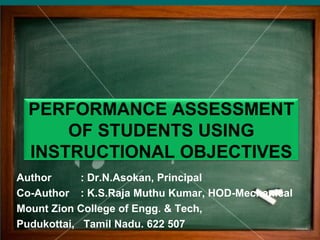
Performance Assessment Using Instructional Objectives
- 1. PERFORMANCE ASSESSMENT OF STUDENTS USING INSTRUCTIONAL OBJECTIVES Author : Dr.N.Asokan, Principal Co-Author : K.S.Raja Muthu Kumar, HOD-Mechanical Mount Zion College of Engg. & Tech, Pudukottai, Tamil Nadu. 622 507
- 2. OBJECTIVES 1. What is important for the students to learn in the limited school and class room time available? (Learning question) 2. How does one plan and deliver instruction that will result in high levels of learning for large numbers of students? (Instruction question) 3. How does one select or design assessment instruments and procedure that provide accurate information about how well students are learning? (Assessment question) 4. How does one ensure that objectives, instruction and assessment are consistent with one another? (Alignment question)
- 3. LEVEL OF OBJECTIVE Global Educational Instructional Scope Broad Moderate Narrow TIME NEEDED TO LEARN One or more years (often many) Weeks or months Hours or days PURPOSE OR FUNCTION Provide vision Design curriculum Prepare lesson plans EXAMPLE OF USE Plan a multiyear curriculum (e.g., elementary reading) Plan units of instruction Plan daily activities, experiences, and exercises
- 4. TAXONOMY FRAMEWORK KNOWLEDGE DIMENSION THE COGNITIVE PROCESS DIMENSION 1. REMEMBER 2. UNDERSTAND 3. APPLY 4. ANALYZE 5. EVALUAT E 6. CREATE A. FACTUAL KNOWLEDGE B. CONCEPTUAL KNOWLEDGE C. PROCEDURAL KNOWLEDGE D. META- COGNITIVE KNOWLEDGE (Adopted from Anderson et al., 2001, p17.)
- 5. METHODOLOGY • 56 students of first year undergraduate Mechanical Engineering - 2008 – 2009 • First unit of Engineering Mechanics subject. • Specifying Instructional Objectives from University syllabus (affiliated system) in terms of the classification of the Taxonomy table.
- 6. FORMAT FOR STATING OBJECTIVES • The student will be able to, or learn to verb noun • Verb indicated the cognitive process and • Noun indicates the knowledge.
- 7. SPECIFIC INSTRUCTIONAL OBJECTIVES 1) To understand the importance of Units & Dimensions 2) To list the Laws of Mechanics 2.1) To define Lami’s theorem 2.2) To define Parallelogram Law of forces 2.3) To define Triangular Law of forces. 3) To Apply the concept of Vectors 3.1) To execute vector operations 3.2) To represent forces in Vectorial form 3.3) To represent moments in Vectorial form 4) To explain the concept of forces 4.1) To explain Resolution of forces 4.2) To explain Composition of forces 5) To explain Equilibrium of a particle 5.1) To explain Equilibrium of a particle in space. 6) To solve problems in Equivalent systems of forces. 7) To explain the concept of Principle of transmissibility. 8) To explain the concept of single equivalent force.
- 8. Analysis of the unit – 1 Objectives in terms of the Taxonomy Table based on stated Objectives
- 10. This examination emphasizes consistency in terms of intended student learning (Objectives 2.0 and 7.0).
- 11. Understand is believed to be more cognitively complex than Remember Apply is believed to be more cognitively complex than Understand and so on.
- 12. RESTATED OBJECTIVES 1. To remember Units & Dimensions 1.1 To explain Units & Dimensions 2. To list the Laws of Mechanics 2.1 To define Lami’s theorem 2.2 To define Parallelogram Law of forces 2.3 To define Triangular Law of forces. 3. To understand the concept of Vectors 3.1 To execute vector operations 3.2 To solve problems in vector operations 3.3 To represent forces in Vectorial form 3.4 To solve problems by representing forces in Vectorial form 3.5 To represent moments in Vectorial form 3.6 To solve problems by representing moments in Vectorial form
- 13. RESTATED OBJECTIVES 4. To explain the concept of forces 4.1 To explain Resolution of forces 4.2 To solve problems in Resolution of forces 4.3 To explain Composition of forces 4.4 To solve problems in Composition of forces 5. To explain Equilibrium of a particle 5.1 To explain Equilibrium of a particle in space. 5.2 To solve problems in Equilibrium of a particle in space. 6. To understand Equivalent systems of forces. 6.1 To solve problems in Equivalent systems of forces. 7. To explain the concept of Principle of transmissibility. 8. To explain the concept of single equivalent force. 8.1To solve problems in single equivalent force
- 14. CONCLUSION • Student-oriented, Learning-based, Explicit, and Assessable statements of intended cognitive outcomes (Specific Instructional Objectives).
- 15. CONCLUSION • Taxonomy Table will help teachers make sense of the curriculum, plan instruction and design assessment that are aligned with the objectives inherent in the curriculum and ultimately improve their teaching quality.
- 16. CONCLUSION • Framework provides a common way of thinking about and a common vocabulary for talking about Teaching, Learning and Assessing
